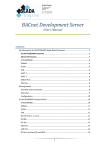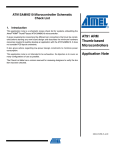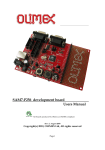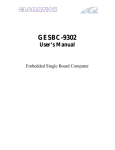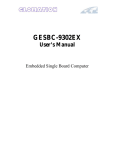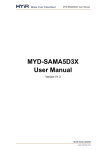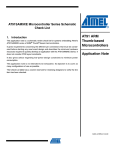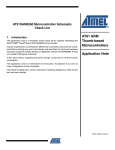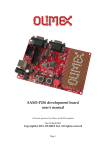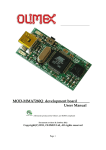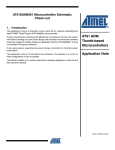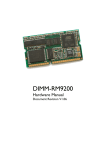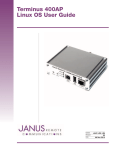Download GESBC-9260/GESBC-9260B User`s Manual
Transcript
Embedded Single Board Computer GESBC-9260/GESBC-9260B User’s Manual GESBC-9260 User’s Manual Table of Contents Chapter 1 – Introducing the GESBC-9260 Single Board Computer .................................. 4 GESBC-9260 Overview.................................................................................................. 4 Advanced Features.......................................................................................................... 4 AT91SAM9260............................................................................................................... 6 SDRAM .......................................................................................................................... 6 FLASH............................................................................................................................ 6 USB................................................................................................................................. 6 UART 1........................................................................................................................... 6 UART 2........................................................................................................................... 7 DEBUG Port ................................................................................................................... 7 Ethernet ........................................................................................................................... 7 Chapter 2 – Getting Started................................................................................................. 8 Assembly and Connections............................................................................................. 8 Operation......................................................................................................................... 8 Configurations............................................................................................................... 10 Chapter 3 – GESBC-9260 Function Blocks ..................................................................... 11 AT91SAM9260............................................................................................................. 11 SDRAM ........................................................................................................................ 11 FLASH.......................................................................................................................... 11 USB............................................................................................................................... 12 RS-232 Port 0, 1, and 2................................................................................................. 12 RS-485 .......................................................................................................................... 13 I2C Bus ......................................................................................................................... 13 Ethernet ......................................................................................................................... 14 SPI Bus, On-chip A/D and GPIO ................................................................................. 14 RTC............................................................................................................................... 16 JTAG............................................................................................................................. 16 Power Requirement....................................................................................................... 16 Chapter 4 – Software Description..................................................................................... 17 Overview....................................................................................................................... 17 Data Storage on GESBC-9260...................................................................................... 17 GESBC-9260 Linux Code ............................................................................................ 17 U-boot ........................................................................................................................... 17 U-boot Booting Linux................................................................................................... 17 Loading Linux Kernel and root File System................................................................. 18 Chapter 5 – Development Tools ....................................................................................... 21 Overview....................................................................................................................... 21 Linux Development Tool Chain ................................................................................... 21 Chapter 6 – Troubleshooting ............................................................................................ 23 Version 0.2 Page 2 of 23 22-Jun-09 GESBC-9260 User’s Manual List of Tables Table 1 System Configuration .......................................................................................... 10 Table 2 P0 connector ....................................................................................................... 12 Table 3 P1 connector ........................................................................................................ 12 Table 4 P2 UART3 connector........................................................................................... 13 Table 5 J8 RS-485............................................................................................................ 13 Table 6 J9 I2C bus ........................................................................................................... 13 Table 7 J16 I/O Expansion............................................................................................... 14 Table 8 J20 JTAG Connector ........................................................................................... 16 Table 9 J1 Power Supply Connector................................................................................. 16 Table 9 NAND FLASH Storage Map............................................................................... 17 Version 0.2 Page 3 of 23 22-Jun-09 GESBC-9260 User’s Manual Chapter 1 – Introducing the GESBC-9260 Single Board Computer GESBC-9260 Overview The GESBC-9260 is a low cost compact sized single board computer based on Atmel AT91SAM9260 processor. With a large peripheral set targeted to a variety of applications, the GESBC-9260 is well suited for industrial controls, digital media servers, audio jukeboxes, thin clients, set-top boxes, point-of-sale terminals, biometric security systems, and GPS devices. Advanced Features The heart of the GESBC-9260 is the AT91SAM9260 which is the one in a series of ARM926EJ-Sbased processors. The AT91SAM9260 microcontroller features DSP Instruction Extensions, ARM Jazelle® Technology for Java® Acceleration. It has separate 8 Kbyte instruction and data caches with write buffer. The ARM926EJ-S on the AT91SAM9260 functions with a maximum operating clock rate of 200MHz and a power usage between 20mW and 250mW (dependent upon clock speed). The ARM core operates from a 1.8V supply while the I/O operates at 3.3V. The low power consumption makes it an idea platform for battery operated applications. The list below summarizes the features of the GESBC-9260. • • • • • • • • • • • • • • • • 200MHz Processor Core – ARM926EJ-S with MMU 64~ 128 MB SDRAM 128MB ~ 1GB NAND FLASH 1 10/100 Mbps Ethernet port 4 channel 10-bit Analog-to-Digital Converter (ADC 3 RS-232 Universal Asynchronous Receiver / Transmitters (UARTs) 1 RS-485 Port 2 USB Host Port 1 USB Device Port Real-Time Clock with battery backup Hardware Debug Interface SD/MMC Socket GPIO Ports with high current drive (up to 16mA) 1 I2C Port 1 SPI Port 32 bit Memory Expansion Bus Figure 1 below shows a picture of the GESBC-9260 Single Board Computer. Version 0.2 Page 4 of 23 22-Jun-09 GESBC-9260 User’s Manual Figure 1. GESBC-9260 Single Board Computer Version 0.2 Page 5 of 23 22-Jun-09 GESBC-9260 User’s Manual AT91SAM9260 The GESBC-9260 is shipped with the Atmel AT91SAM9260 processor. For more information regarding the AT91SAM9260 processor please see the AT91SAM9260 datasheet. SDRAM The GESBC-9260 is shipped with 64MBytes of SDRAM. FLASH The GESBC-9260 is shipped with 128MB NAND FLASH. USB The GESBC-9260 is shipped with two USB host ports. UART 1 The GESBC-9260 is shipped with a full RS-232 interface with modem control signals Version 0.2 Page 6 of 23 22-Jun-09 GESBC-9260 User’s Manual UART 2 The GESBC-9260 is shipped with the 3 wire UART 2 interface. DEBUG Port The GESBC-9260 is shipped with the 3 wire serial debug port. Ethernet The GESBC-9260 is shipped with a complete physical and MAC subsystem that is compliant with the ISO/TEC 802.3 topology for a single shared medium with several stations. The AT91SAM9260 supports 1/10/100 Mbps transfer rates and interfaces to industry standard physical layer devices. Version 0.2 Page 7 of 23 22-Jun-09 GESBC-9260 User’s Manual Chapter 2 – Getting Started This chapter describes the GESBC-9260 working environment and familiarizes the user with its components and functionality. This chapter contains the following sections: • Assembly and Connections o Describes how to assemble and connect components to the GESBC-9260 Single Board Computer • Operation o Describes how to operate the GESBC-9260 Single Board Computer Assembly and Connections In order to use the GESBC-9260 the user must first assemble and connect the peripherals to the GESBC-9260, as described in the following procedure. 1. Place the GESBC-9260 on a static free surface. 2. Make sure all of the jumpers are in the factory default position. The unit is shipped in a factory default configuration. If the user is uncertain that the GESBC-9260 has the jumpers in the factory default configuration, please see the next section regarding board configuration. 3. Connect 5V regulated power supply to J1 on the board. 4. Connect null modem serial cable between GESBC-9260 debug port and PC/terminal serial port. 5. Launch a terminal emulator, such as HyperTerminal, or minicom, on the PC configured to connect to the serial port of the GESBC-9260. Configure the serial port with the following parameters: 115200 bits per second, 8 data bits, no parity, 1 stop bit, no flow control. 6. Connect the board to a local area network (optional) Operation A few seconds after applying power to the GESBC-9260, debug information will be displayed on the terminal program. The following figures show what this should look like. Version 0.2 Page 8 of 23 22-Jun-09 GESBC-9260 User’s Manual Please see Version 0.2 Page 9 of 23 22-Jun-09 GESBC-9260 User’s Manual Chapter 4 – Software Description for more details regarding the software functionality. Configurations Jumpers are used to configure the GESBC-9260 to operate in different mode. The following table lists all the settings for each jumper. Jumper J7 S1 BP1 Version 0.2 Table 1 System Configuration Description Boot mode: connect pin 1 and 2 – external memory boot on NCS0 open pin 1 and 2 – internal ROM boot (NAND FLASH boot) PA31 port input for boot strap code boot mode open – normal ROM boot sequence close – ROM debug mode System reset switch header Page 10 of 23 22-Jun-09 GESBC-9260 User’s Manual Chapter 3 – GESBC-9260 Function Blocks AT91SAM9260 The GESBC-9260 Single Board Computer uses the Atmel AT91SAM9260 as the core processor on this development board. The top-level features of AT91SAM9260 processor are the following: • ARM926EJ-S RISC Core Processor • 200 MHz / 200 MIPS Performance • 8Kbyte Instruction Cache • 8 Kbyte Data Cache • Linux and Windows CE enabled MMU • 100 MHz System Bus • 32 bit SDRAM Interface • 32 bit SRAM / FLASH / ROM Interface • Serial EEPROM Interface • 10 / 100 Mbps Ethernet MAC • 6 UART • Two-port USB Host • 4 channel 10 bit ADC • 2 SPI Port • Serial Audio Interface • JTAG Interface More detailed information regarding the AT91SAM9260 processor can be found at www.atmel.com. SDRAM The AT91SAM9260 features a unified memory address model where all memory devices are accessed over a common address and data bus. The GESBC-9260 up 128MB SDRAM. FLASH The GESBC-9260 is shipped with 128 Mbytes of NAND FLASH memory. The GESBC-9260 can be also ordered with optional 256MB ~ 1GB NAND FLASH. Version 0.2 Page 11 of 23 22-Jun-09 GESBC-9260 User’s Manual USB The GESBC-9260 Single Board Computer provides two USB host connections. The AT91SAM9260 USB host controller is configured for two root hub ports and features an integrated transceiver for each port. The AT91SAM9260 integrates two USB 2.0 Full Speed host ports. These ports are fully compliant to the OHCI USB 2.0 Full Speed specification (12 Mbps). The controller complies with the OHCI specification for USB Revision 1.1. The USB ports are brought out by a standard double deck USB type A connector. The GESBC-9260 Single Board Computer provides one USB device port. The USB Device Port (UDP) is compliant with the Universal Serial Bus (USB) V2.0 full-speed device specification. RS-232 Port 0, 1, and 2 The GESBC-9260 Single Board Computer is shipped with two 3-wire RS-232 UART interface, and one 9 wire RS-232 UART interface. The port 0 is the debug USART port of the AT91SAM9260. The P0 connector is the DB-9 connector on GESBC-9260 and 3 pin header on GESBC-9260B. The signal designation is listed in the following tables. Pin Number 1 3 5 7 9 Table 2 Debug UART Port P0 Connector on GESBC-9260 Signal Name Pin Number Signal Name NC 2 RX TX 4 NC GND 6 NC NC 8 NC NC 10 N/A Table 3 UART Port Pin Number 1 2 3 P0 Connector on GESBC-9260B Signal Name RX TX GND The serial port 1 is the USART 0 on the AT91SAM9260 processor. It is provided via a 2x5 2.54mm spacing header P1 on GESBC-9260. It is provided via the DB-9 connector on GESBC9260B. The UART P1 provides full modem control and hardware handshake signals. Pin Number 1 3 5 Version 0.2 Table 4 UART Port P1 Connector Signal Name Pin Number Signal Name DCD 2 RX TX 4 DTR GND 6 DSR Page 12 of 23 22-Jun-09 GESBC-9260 User’s Manual 7 9 RTS RI 8 10 CTS NC/NA The port 2 is the USART 1 of the AT91SAM9260. It is provided via a 3 pin header P2. Table 5 UART3 Port 2 Connector Pin Number Signal Name 1 RX 2 TX 3 GND RS-485 The GESBC-9260 Single Board Computer provides one half duplex RS-485 port. The RS-485 port is connected to USART3 with RTS signal for RS-485 driver direction control. The RS-485 signal is provided via a 1x3 2.54mm spacing header J8. J6 enables the on-board 120 ohm termination resistor. Table 6 RS-485 Port J8 Pin Number Signal Name 1 A 2 B 3 GND The RTS3 is connected to the RS-485 driver chip for data direction control. The normal setting of RTS signal is normally low. For RS-485 mode the RTS signal must set to normally high. The user program must set the RTS mode before RS-485 port can be used. I2C Bus The GESBC-9260 Single Board Computer provides one I2C bus interface via a 1x3 2.54mm spacing header J9. Table 7 J9 I2C bus Pin Number 1 2 3 Version 0.2 Signal Name SDA SCL GND Page 13 of 23 22-Jun-09 GESBC-9260 User’s Manual Ethernet The GESBC-9260 Single Board Computer is shipped with support for a complete Ethernet interface. The AT91SAM9260 contains a MAC subsystem that is compliant with the ISO/TEC 802.3 topology for a single shared medium with several stations. The Media Access Controller (MAC) within the AT91SAM9260 supports 1/10/100 Mbps transfer rates and interfaces to industry standard physical layer devices. The GESBC-9260 is shipped with the DM9161A 100Base-X / 10Base-T Transceiver device which, along with a RJ45 connector, provides the physical layer interface. USB Port The GESBC-9260 Single Board Computer is shipped with 2 USB host port on standard USB typeA double deck connector. The GESBC-9260 Single Board Computer is shipped with one USB device port J17. The USB device port signal assignment is listed in the following table. Table 8 J17 USB Device Port Pin Number Signal Name 1 USB connection 2 DM 3 DP 4 GROUND 5 GROUND SPI Bus, On-chip A/D and GPIO The AT91SAM9260 contains very rich set of peripherals that are multiplex into 2 groups, Peripheral A and Peripheral B, with individually programmable pins. The SPI bus, A/D and GPIO are provided together with other functions on the I/O expansion port. The I/O expansion port is a 2x25 2.54mm spacing header. The following table lists signals available on the I/O expansion connector with their corresponding multiplexed functions and default usage on the GESBC-9260 Single Board Computer. Table 9 J16 I/O Expansion Pin I/O Line Peripheral A 1 PB0 SPI1_MISO 2 PB1 SPI1_MOSI 3 PB2 SPI1_SPCK 4 PB3 SPI1_NPCS0 5 PB4 TXD0 6 PB5 RXD0 7 PB6 TXD1 8 PB7 RXD1 9 PB8 TXD2 Version 0.2 Peripheral B TIOA3 TIOB3 TIOA4 TIOA5 TCLK1 TCKL2 Page 14 of 23 Comments Function RS-232 Port 1 RS-232 Port 1 RS-232 Port 2 RS-232 Port 2 22-Jun-09 GESBC-9260 User’s Manual 10 11 12 13 14 15 16 17 18 19 20 21 22 23 24 25 26 27 28 29 30 31 32 33 34 35 36 37 38 39 40 41 42 43 44 45 46 47 48 49 50 PB9 PB10 PB11 PB12 PB13 PB14 PB15 PB16 PB17 PB18 PB19 PB20 PB21 PB22 PB23 PB24 PB25 PB26 PB27 PB28 PB29 PB30 PB31 RXD2 TXD3 RXD3 TXD5 RXD5 DRXD DTXD TK0 TF0 TD0 RD0 RK0 RF0 DSR0 DCD0 RTR0 RI0 RTC0 CTS0 RTS1 CTS1 PCK0 PCK1 ISI_D8 ISI_D9 ISI_D10 ISI_D11 RS-485 Port RS-485 Port RS-232 Port 0 RS-232 Port 0 TCLK3 TCLK4 TIOB4 TIOB5 ISI_D0 ISI_D1 ISI_D2 ISI_D3 ISI_D4 ISI_D5 ISI_D6 ISI_D7 ISI_PCK ISI_VSYNC ISI_HSYNC ISIMCK RS-232 Port 1 RS-232 Port 1 RS-232 Port 1 RS-232 Port 1 RS-232 Port 1 RS-232 Port 1 GND GND PC0 PC1 PC2 PC3 PC4 PC5 PC6 PC7 PC8 PC9 PC10 PC11 AD0 AD1 AD2 AD3 A23 A24 TIOB2 TIOB3 NCS4/CFCS0 NCS5/CFCS1 A25/CFRNW NCS2 SCK3 PCK0 PCK1 SPI1_NPCS3 SPI1_NPCS2 SPI1_NPCS1 CFCE1 CFCE2 RTS3 TIOB0 CTS3 SPI-_NPCS1 RS-485 GND GND 3.3V 3.3V For more detailed information on multiplexed peripherals please see AT91SAM9260 data sheet. Version 0.2 Page 15 of 23 22-Jun-09 GESBC-9260 User’s Manual RTC The GESBC-9260 uses the AT91SAM9260 on-chip RTC with battery hook-up to provide accurate time keeping. The on-board battery holder accepts CR1225/CR1220 coin cell batteries. JTAG The GESBC-9260 Single Board Computer is shipped with a 10 pin connector that provides JTAG debug signals for the CPU. The JTAG provides the user with the ability to debug system level programs. The signal designation is listed in the following table. Pin Number 1 3 5 7 9 Table 10 J20 JTAG Connector Signal Name Pin Number Signal Name 3.3V 2 3.3V NTRST 4 TDI TMS 6 TCK RTCK 8 TDO GND 10 GND Power Requirement The GESBC-9260 Single Board Computer requires regulated 5V DC. The power supply should have minimum 350mA capacity. Table 11 J1 Power Supply Connector Pin Number Signal Name 1 5V DC 2 GND Version 0.2 Page 16 of 23 22-Jun-09 GESBC-9260 User’s Manual Chapter 4 – Software Description Overview This chapter provides information regarding the software that is shipped with the GESBC-9260 Board. The software included with the board is U-boot boot loader, Linux kernel 2.6.25, and Debian distribution style compact root file system. The applications included provide access to all hardware functions on the GESBC-9260 board. Data Storage on GESBC-9260 The default configuration of the GESBC-9260 Single Board Computer uses on board NAND FLASH for all data storage requirements, including boot strap code, boot loader, Linux kernel, and Linux file system. The following table is the storage map on the NAND FLASH. Table 12 NAND FLASH Storage Map Start Address Size Usage 0x00000000 0x20000 Boot strap code 0x00020000 0x40000 U-boot 0x00060000 0x40000 U-boot primary environment storage range 0x000A0000 0x40000 U-boot secondary environment storage range 0x00100000 0x300000 Linux kernel 0x00400000 -Root file system GESBC-9260 Linux Code The GESBC-9260 is shipped with Linux 2.6.27 kernel pre-installed. This software is programmed into the system FLASH located on the board prior to shipment. The Linux kernel is configured with all the device drivers included for the GESBC-9260 board. U-boot U-boot provides a simple interface for loading operating systems and applications onto the GESBC-9260 board. U-Boot uses a serial console for its input and output. The default serial port setting is 115200,8,N,1. It also supports the built-in Ethernet port and general flash programming. The board is shipped with U-boot pre-installed. Please refer to U-boot user’s manual regarding detailed information of U-boot. U-boot Booting Linux The following shows the default U-boot setup for booting Linux. Version 0.2 Page 17 of 23 22-Jun-09 GESBC-9260 User’s Manual U-Boot> printenv bootargs=console=ttyS0,115200 root=/dev/mtdblock2 rw rootfstype =jffs2 mtdparts=atmel_nand:1M(bootloader),3M(kernel),-(rootfs) bootcmd=nand read.jffs2 0x22000000 0x100000 0x200000; bootm bootdelay=1 baudrate=115200 ethaddr=00:0c:20:02:0a:5b ipaddr=192.168.0.200 serverip=192.168.0.102 netmask=255.255.255.0 stdin=serial stdout=serial stderr=serial ethact=macb0 Environment size: 353/131067 bytes U-Boot> The bootcmd setting of the U-boot reads the Linux kernel from NAND FLASH at address 0x100000 to SDRAM at address 0x22000000 and start executing the kernel code at the same memory address. The NAND FLASH from 0x400000 and up is used for Linux root file system. The U-boot passes the MTD device partition setting to the Linux kernel via the bootargs environment variable. Loading Linux Kernel and root File System The U-boot boot-loader provides many ways to load Linux kernel and file system into FLASH memory. The loading by Ethernet network is shown here. User can consult U-boot manual for other methods of loading data. After power on the GESBC-9260 board, stop the U-boot auto-execution by press any key. The following message should be shown on the terminal console on the host PC connected to the GESBC-9260 board. Version 0.2 Page 18 of 23 22-Jun-09 GESBC-9260 User’s Manual RomBOOT > U-Boot 1.3.3 (Jul 19 2008 - 15:50:33) DRAM: 64 MB NAND: 128 MiB DataFlash:AT45DB642 Nb pages: 8192 Page Size: 1056 Size= 8650752 bytes Logical address: 0xD0000000 Area 0: D0000000 to D00041FF (RO) Bootstrap Area 1: D0004200 to D00083FF Environment Area 2: D0008400 to D0041FFF (RO) U-Boot Area 3: D0042000 to D0251FFF Kernel Area 4: D0252000 to D083FFFF FS In: serial Out: serial Err: serial Net: macb0 macb0: Starting autonegotiation... macb0: Autonegotiation timed out (status=0x7849) macb0: link up, 100Mbps full-duplex (lpa: 0x4de1) Hit any key to stop autoboot: 0 U-Boot> The net work address and server address must be set before network transfer can take place. The following commands will set the SBC IP address and server IP address, set ipaddr xxx.xxx.xxx.xxx set serverip xxx.xxx.xxx.xxx The server IP is the IP address where a TFTP server must be run. To load Linux kernel type in the following command, t 0x22000000 uImage The U-boot will load uImage file from the TFTP server whose IP address is specified by the serverip environment vairbale. The NAND FLASH sectors must be erased first before new kernel image can be stored. The following command will erase the NAND FLASH sectors reserved for Linux kernel, nand erase 0x100000 0x200000 The use the flowing command to store the kernel image from SDRAM to NAND FLASH, nand write.jffs2 0x22000000 0x100000 0x200000 Version 0.2 Page 19 of 23 22-Jun-09 GESBC-9260 User’s Manual The following commands can be used to load root file system into the FLASH memory, nand erase 0x400000 [available_nand_flash_memory_size] t 0x21000000 rootfs.img nand write.jffs2 0x21000000 x0400000 $(filesize) Please be noted that the image is first loaded into the SDRAM and then stored into the FLASH memory. The image size can not exceed the available SDRAM on the board. After the kernel and root file system have been updated the board can be simply reboot by recycle the power. Version 0.2 Page 20 of 23 22-Jun-09 GESBC-9260 User’s Manual Chapter 5 – Development Tools Overview This chapter provides a brief introduction to development tools that are available for the AT91SAM9260 System-on-a-Chip processor. The central processing core on the AT91SAM9260 is a 200 MHz ARM926EJ-S processor. The ARM926EJ-S RISC processing core is supported through various toolsets available from third party suppliers. The typical toolset required for the code development is a compiler, assembler, linker and a source-level code debugger. Code debugging is supported via the on-chip JTAG interface. Linux Development Tool Chain The Linux development tool chain is available at Glomation website in the support page. A host PC running Linux operating system is required to run the development tools. This guide assumes user had basic Linux or Unix application development knowledge. Host Computer Requirement The host PC should run Redhead, SuSe, or other Linux distribution, a RS-232 serial port, at least 500MB free disk space, and a terminal program such as minicom. Hardware Connection A null modem cable is required to connect GESBC-9260 to the host computer. Install Linux Development Tool Chain The ARM Linux Development Tool chain can be installed in any directory on the host system. The following example uses cross compiler default directory /usr/local/arm as the installing directory for the ARM Linux cross compiler. 1. Login as root and untar the tool chain cd / tar jxvf /<cross compiler tar file directory>/ Generic-arm_gcc-4.2.3glibc-2.3.3.tar.bz2 2. Set up the directory path variable export PATH=/usr/local/arm/gcc-4.2.3-glibc-2.3.3/arm-unknown-linuxgnu/bin:$PATH Version 0.2 Page 21 of 23 22-Jun-09 GESBC-9260 User’s Manual above command can be included in the shell resource file so it is executed every time you login. For bash shell, a good place to put is in .bashrc in your home directory. Compile Linux Kernel The GESBC-9260 is shipped with Linux kernel version 2.6.27. The patch for the kernel source tree is available at Glomation website in the support page. Prepare Linux Kernel source Obtain the kernel source 2.6.27 from http://www.kernel.org. Untar the Linux kernel, tar xjf linue-2.6.27.bz2 Obtain the kernel patch from http://www.linux4sam.org/twiki/bin/view/Linux4SAM/LinuxKernel. Patch the kernel source with the following command, patch –p1 < /<patch-file-directory-path>/patch_file_name Configure Linux Kernel The GESBC-9260 can use the default configuration file for the Atmel AT91SAM9260-ek evaluation board. make ARCH=arm CROSS_COMPILE=arm-unknown-linux-gnuat91sam9260ek_defconfig If additional configuration is required, executing the following command in the Linux kernel directory, make ARCH=arm CROSS_COMPILE=arm-unknown-linux-gnu- menuconfig If problem occurs, make sure the default PATH variable is set to the correct tool chain directory Compile Kernel Once Linux kernel has been configured, it can be compiled using following command, make ARCH=arm CROSS_COMPILE=arm-unknown-linux-gnu- uImage The Linux kernel should compile without error and the image file will be created. Version 0.2 Page 22 of 23 22-Jun-09 GESBC-9260 User’s Manual Chapter 6 – Troubleshooting This chapter provides Troubleshooting information. Search the entries in the Problem column in order to find the item that best describes your situation. Then perform the corrective action in the same row. If the problem persists, contact Glomation. Version 0.2 Page 23 of 23 22-Jun-09























